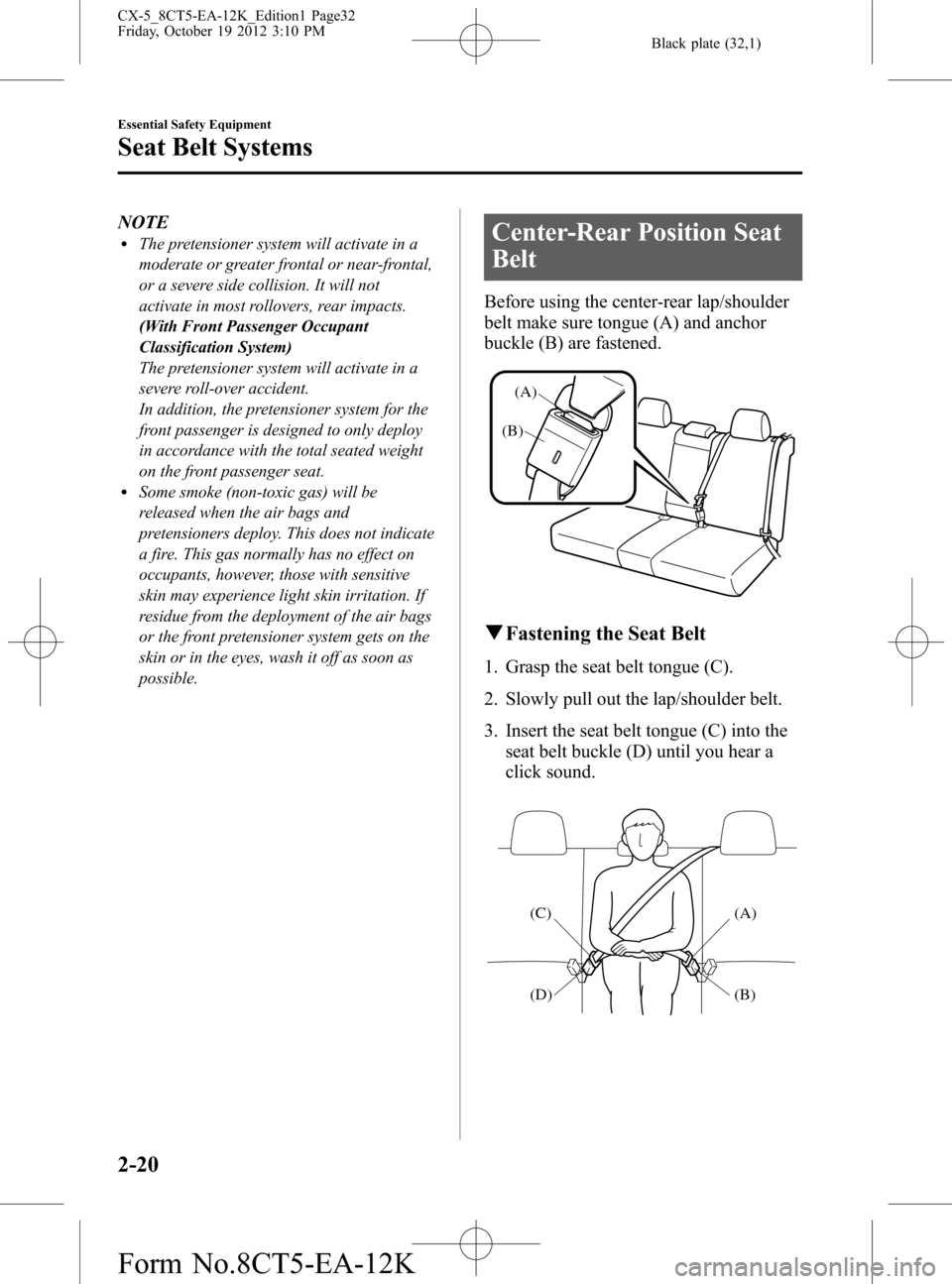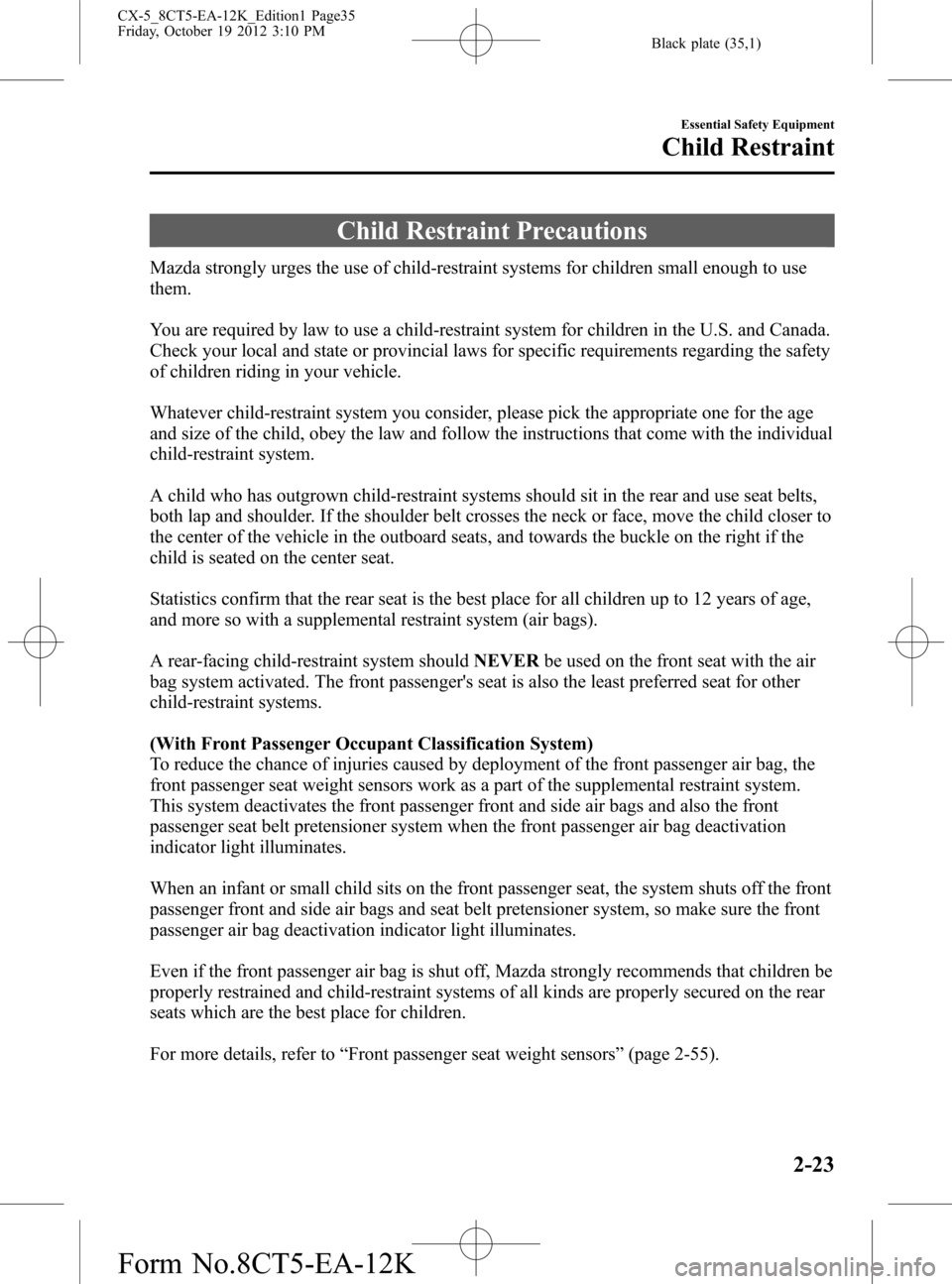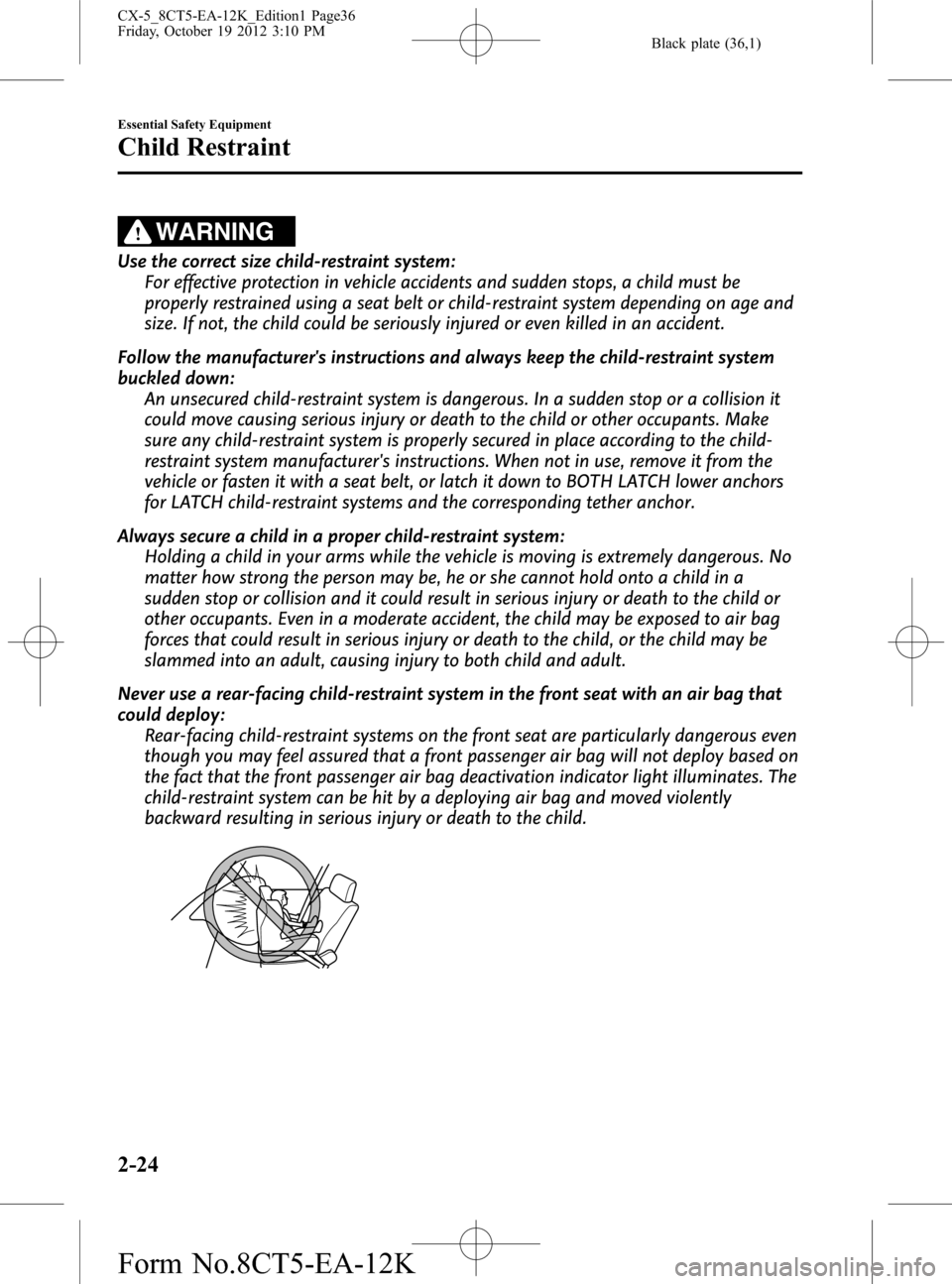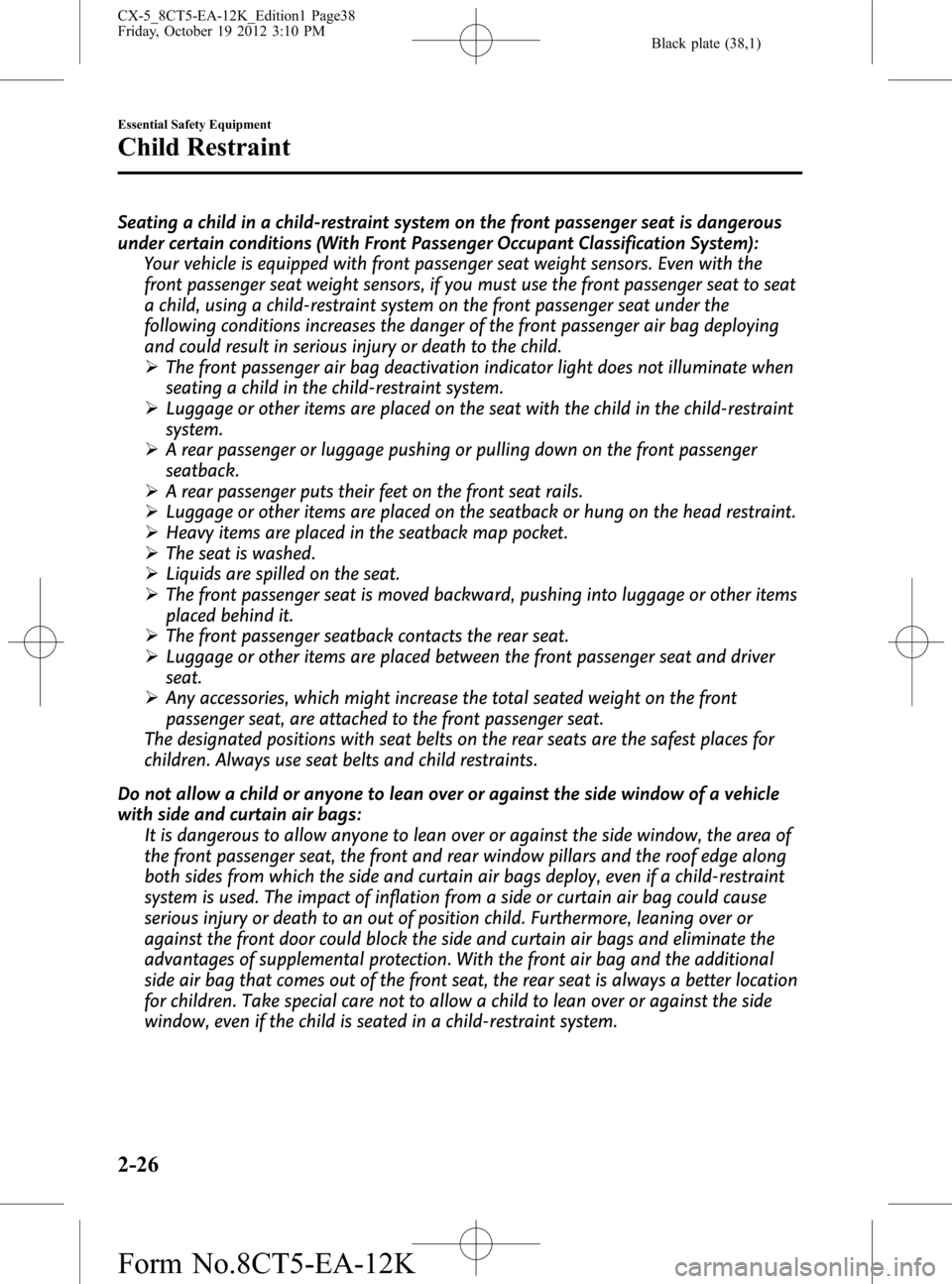MAZDA MODEL CX-5 2014 (in English) Owner's Guide
Manufacturer: MAZDA, Model Year: 2014, Model line: MODEL CX-5, Model: MAZDA MODEL CX-5 2014Pages: 528, PDF Size: 7.97 MB
Page 31 of 528

Black plate (31,1)
Load limiter:
The load limiting system releases belt
webbing in a controlled manner to reduce
belt force on the occupant's chest. While
the most severe load on a seat belt occurs
in frontal collisions, the load limiter has
an automatic mechanical function and can
activate in any accident mode with
sufficient occupant movement.
Even if the pretensioners have not fired,
the load limiting function must be
checked by an Authorized Mazda Dealer.
WARNING
Wear seat belts only as recommended
in this owner's manual:
Incorrect positioning of the driver and
front passenger seat belts is
dangerous. Without proper
positioning, the pretensioner and
load limiting systems cannot provide
adequate protection in an accident
and this could result in serious injury.
For more details about wearing seat
belts, refer to“Fastening the seat
belts”(page 2-17).Have your seat belts changed
immediately if the pretensioner or load
limiter has been expended:
Always have an Authorized Mazda
Dealer immediately inspect the front
seat belt pretensioners and air bags
after any collision. Like the air bags,
the front seat belt pretensioners and
load limiters will only function once
and must be replaced after any
collision that caused them to deploy.
A seat belt with an expended
pretensioner or load limiter is still
better than wearing no seat belt at
all; however, if the front seat belt
pretensioners and load limiters are
not replaced, the risk of injury in a
collision will increase.
Do not modify the components or
wiring, or use electronic testing devices
on the pretensioner system:
Modifying the components or wiring
of the pretensioner system, including
the use of electronic testing devices is
dangerous. You could accidentally
activate it or make it inoperable
which would prevent it from
activating in an accident. The
occupants or repairers could be
seriously injured.
Properly dispose of the pretensioner
system:
Improper disposal of the pretensioner
system or a vehicle with non-
deactivated pretensioners is
dangerous. Unless all safety
procedures are followed, injury could
result. Have an Authorized Mazda
Dealer safely dispose of the
pretensioner system or scrap a the
pretensioner system equipped vehicle.
Essential Safety Equipment
Seat Belt Systems
2-19
CX-5_8CT5-EA-12K_Edition1 Page31
Friday, October 19 2012 3:10 PM
Form No.8CT5-EA-12K
Page 32 of 528

Black plate (32,1)
NOTElThe pretensioner system will activate in a
moderate or greater frontal or near-frontal,
or a severe side collision. It will not
activate in most rollovers, rear impacts.
(With Front Passenger Occupant
Classification System)
The pretensioner system will activate in a
severe roll-over accident.
In addition, the pretensioner system for the
front passenger is designed to only deploy
in accordance with the total seated weight
on the front passenger seat.
lSome smoke (non-toxic gas) will be
released when the air bags and
pretensioners deploy. This does not indicate
a fire. This gas normally has no effect on
occupants, however, those with sensitive
skin may experience light skin irritation. If
residue from the deployment of the air bags
or the front pretensioner system gets on the
skin or in the eyes, wash it off as soon as
possible.
Center-Rear Position Seat
Belt
Before using the center-rear lap/shoulder
belt make sure tongue (A) and anchor
buckle (B) are fastened.
(A)
(B)
qFastening the Seat Belt
1. Grasp the seat belt tongue (C).
2. Slowly pull out the lap/shoulder belt.
3. Insert the seat belt tongue (C) into the
seat belt buckle (D) until you hear a
click sound.
(A)
(B) (C)
(D)
2-20
Essential Safety Equipment
Seat Belt Systems
CX-5_8CT5-EA-12K_Edition1 Page32
Friday, October 19 2012 3:10 PM
Form No.8CT5-EA-12K
Page 33 of 528

Black plate (33,1)
WARNING
Fastening the Center-Rear Seat Belt
with Only One Buckle:
Fastening the center-rear seat belt
with only one buckle is dangerous. If
only one pair of seat belt tongues
and buckles is fastened (either seat
belt tongue (C) and seat belt anchor
buckle (D) or seat belt tongue (A) and
seat belt buckle (B)), then the seat
belt cannot provide full protection. In
a sudden stop or collision, the user
could slide under the belt and suffer
serious injuries. Always make sure
that both pairs of seat belt tongues
and buckles are fastened properly.
Seat Belt Extender
If your seat belt is not long enough, even
when fully extended, a seat belt extender
may be available to you at no charge from
your Authorized Mazda Dealer.
This extender will be only for you and for
the particular vehicle and seat. Even if it
plugs into other seat belts, it may not hold
in the critical moment of a crash.
When ordering an extender, only order
one that provides the necessary additional
length to fasten the seat belt properly.
Please contact your Authorized Mazda
Dealer for more information.
WARNING
Do not use a seat belt extender unless
it is necessary:
Using a seat belt extender when not
necessary is dangerous. The seat belt
will be too long and not fit properly.
In an accident, the seat belt will not
provide adequate protection and you
could be seriously injured. Only use
the extender when it is required to
fasten the seat belt properly.
Essential Safety Equipment
Seat Belt Systems
2-21
CX-5_8CT5-EA-12K_Edition1 Page33
Friday, October 19 2012 3:10 PM
Form No.8CT5-EA-12K
Page 34 of 528

Black plate (34,1)
Do not use an improper extender:
Using a seat belt extender that is for
another person or a different vehicle
or seat is dangerous. The seat belt
will not provide adequate protection
and the user could be seriously
injured in an accident. Only use the
extender provided for you and for the
particular vehicle and seat. NEVER
use the extender in a different vehicle
or seat. If you sell your Mazda, do
not leave your seat belt extender in
the vehicle. It could be used
accidentally by the new owner of the
vehicle. After removing the seat belt
extender, discard it. Never use the
seat belt extender in any other
vehicle you may own in the future.
Do not use an extender that is too
long:
Using an extender that is too long is
dangerous. The seat belt will not fit
properly. In an accident, the seat belt
will not provide adequate protection
and you could be seriously injured.
Do not use the extender or choose
one shorter in length if the distance
between the extender's buckle and
the center of the user's body is less
than 15 cm (6 in).Do not leave a seat belt extender
connected to the buckle:
Leaving a seat belt extender
connected to the buckle without
using the seat belt is dangerous.
When the seat belt extender is
connected to the driver's seat belt
buckle (or front passenger) seat, the
SRS driver's (or front passenger's) air
bag system will determine that the
driver (or front passenger) is wearing
the seat belt even if the driver (or
front passenger) is not wearing it.
This condition could cause the
driver's (or front passenger's) air bag
to not activate correctly and result in
death or serious injury in the event of
collision. Always wear the seat belt
with the seat belt extender.
Do not use the seat belt extender when
installing a child-restraint system on
the front or rear passenger seat:
Using a seat belt extender to fasten a
child-restraint system on any seat is
dangerous. Always follow the child-
restraint system manufacturer's
installation instructions and never
use a seat belt extender.
NOTE
When not in use, remove the seat belt extender
and store it in the vehicle. If the seat belt
extender is left connected, the seat belt
extender might get damaged as it will not
retract with the rest of the seat belt and can
easily fall out of the door when not in use and
be damaged. In addition, the seat belt warning
light will not illuminate and function properly.
2-22
Essential Safety Equipment
Seat Belt Systems
CX-5_8CT5-EA-12K_Edition1 Page34
Friday, October 19 2012 3:10 PM
Form No.8CT5-EA-12K
Page 35 of 528

Black plate (35,1)
Child Restraint Precautions
Mazda strongly urges the use of child-restraint systems for children small enough to use
them.
You are required by law to use a child-restraint system for children in the U.S. and Canada.
Check your local and state or provincial laws for specific requirements regarding the safety
of children riding in your vehicle.
Whatever child-restraint system you consider, please pick the appropriate one for the age
and size of the child, obey the law and follow the instructions that come with the individual
child-restraint system.
A child who has outgrown child-restraint systems should sit in the rear and use seat belts,
both lap and shoulder. If the shoulder belt crosses the neck or face, move the child closer to
the center of the vehicle in the outboard seats, and towards the buckle on the right if the
child is seated on the center seat.
Statistics confirm that the rear seat is the best place for all children up to 12 years of age,
and more so with a supplemental restraint system (air bags).
A rear-facing child-restraint system shouldNEVERbe used on the front seat with the air
bag system activated. The front passenger's seat is also the least preferred seat for other
child-restraint systems.
(With Front Passenger Occupant Classification System)
To reduce the chance of injuries caused by deployment of the front passenger air bag, the
front passenger seat weight sensors work as a part of the supplemental restraint system.
This system deactivates the front passenger front and side air bags and also the front
passenger seat belt pretensioner system when the front passenger air bag deactivation
indicator light illuminates.
When an infant or small child sits on the front passenger seat, the system shuts off the front
passenger front and side air bags and seat belt pretensioner system, so make sure the front
passenger air bag deactivation indicator light illuminates.
Even if the front passenger air bag is shut off, Mazda strongly recommends that children be
properly restrained and child-restraint systems of all kinds are properly secured on the rear
seats which are the best place for children.
For more details, refer to“Front passenger seat weight sensors”(page 2-55).
Essential Safety Equipment
Child Restraint
2-23
CX-5_8CT5-EA-12K_Edition1 Page35
Friday, October 19 2012 3:10 PM
Form No.8CT5-EA-12K
Page 36 of 528

Black plate (36,1)
WARNING
Use the correct size child-restraint system:
For effective protection in vehicle accidents and sudden stops, a child must be
properly restrained using a seat belt or child-restraint system depending on age and
size. If not, the child could be seriously injured or even killed in an accident.
Follow the manufacturer's instructions and always keep the child-restraint system
buckled down:
An unsecured child-restraint system is dangerous. In a sudden stop or a collision it
could move causing serious injury or death to the child or other occupants. Make
sure any child-restraint system is properly secured in place according to the child-
restraint system manufacturer's instructions. When not in use, remove it from the
vehicle or fasten it with a seat belt, or latch it down to BOTH LATCH lower anchors
for LATCH child-restraint systems and the corresponding tether anchor.
Always secure a child in a proper child-restraint system:
Holding a child in your arms while the vehicle is moving is extremely dangerous. No
matter how strong the person may be, he or she cannot hold onto a child in a
sudden stop or collision and it could result in serious injury or death to the child or
other occupants. Even in a moderate accident, the child may be exposed to air bag
forces that could result in serious injury or death to the child, or the child may be
slammed into an adult, causing injury to both child and adult.
Never use a rear-facing child-restraint system in the front seat with an air bag that
could deploy:
Rear-facing child-restraint systems on the front seat are particularly dangerous even
though you may feel assured that a front passenger air bag will not deploy based on
the fact that the front passenger air bag deactivation indicator light illuminates. The
child-restraint system can be hit by a deploying air bag and moved violently
backward resulting in serious injury or death to the child.
2-24
Essential Safety Equipment
Child Restraint
CX-5_8CT5-EA-12K_Edition1 Page36
Friday, October 19 2012 3:10 PM
Form No.8CT5-EA-12K
Page 37 of 528

Black plate (37,1)
Vehicles with a front passenger air bag have a warning label attached as shown
below. The warning label reminds you not to put a rear-facing child-restraint system
on the front passenger seat at any time.
Do not install a front-facing child-restraint system on the front passenger seat unless
it is unavoidable:
In a collision, the force of a deploying air bag could cause serious injury or death to
the child. If installing a front-facing child-restraint system on the front passenger
seat is unavoidable, move the front passenger seat as far back as possible.
Essential Safety Equipment
Child Restraint
2-25
CX-5_8CT5-EA-12K_Edition1 Page37
Friday, October 19 2012 3:10 PM
Form No.8CT5-EA-12K
Page 38 of 528

Black plate (38,1)
Seating a child in a child-restraint system on the front passenger seat is dangerous
under certain conditions (With Front Passenger Occupant Classification System):
Your vehicle is equipped with front passenger seat weight sensors. Even with the
front passenger seat weight sensors, if you must use the front passenger seat to seat
a child, using a child-restraint system on the front passenger seat under the
following conditions increases the danger of the front passenger air bag deploying
and could result in serious injury or death to the child.
ØThe front passenger air bag deactivation indicator light does not illuminate when
seating a child in the child-restraint system.
ØLuggage or other items are placed on the seat with the child in the child-restraint
system.
ØA rear passenger or luggage pushing or pulling down on the front passenger
seatback.
ØA rear passenger puts their feet on the front seat rails.
ØLuggage or other items are placed on the seatback or hung on the head restraint.
ØHeavy items are placed in the seatback map pocket.
ØThe seat is washed.
ØLiquids are spilled on the seat.
ØThe front passenger seat is moved backward, pushing into luggage or other items
placed behind it.
ØThe front passenger seatback contacts the rear seat.
ØLuggage or other items are placed between the front passenger seat and driver
seat.
ØAny accessories, which might increase the total seated weight on the front
passenger seat, are attached to the front passenger seat.
The designated positions with seat belts on the rear seats are the safest places for
children. Always use seat belts and child restraints.
Do not allow a child or anyone to lean over or against the side window of a vehicle
with side and curtain air bags:
It is dangerous to allow anyone to lean over or against the side window, the area of
the front passenger seat, the front and rear window pillars and the roof edge along
both sides from which the side and curtain air bags deploy, even if a child-restraint
system is used. The impact of inflation from a side or curtain air bag could cause
serious injury or death to an out of position child. Furthermore, leaning over or
against the front door could block the side and curtain air bags and eliminate the
advantages of supplemental protection. With the front air bag and the additional
side air bag that comes out of the front seat, the rear seat is always a better location
for children. Take special care not to allow a child to lean over or against the side
window, even if the child is seated in a child-restraint system.
2-26
Essential Safety Equipment
Child Restraint
CX-5_8CT5-EA-12K_Edition1 Page38
Friday, October 19 2012 3:10 PM
Form No.8CT5-EA-12K
Page 39 of 528

Black plate (39,1)
Never use one seat belt on more than one person at a time:
Using one seat belt for more than one person at a time is dangerous. A seat belt
used in this way cannot spread the impact forces properly and the two passengers
could be crushed together and seriously injured or even killed. Never use one belt for
more than one person at a time and always operate the vehicle with each occupant
properly restrained.
Always remove the child-restraint system from the rear seat before operating the
remote handle levers for the rear seat:
Operating the remote handle levers while a rear-facing child-restraint system is in
the rear seat is dangerous. It could cause injury to a child seated in the child-
restraint system when the seatback suddenly flips forward.
CAUTION
A seat belt or child-restraint system can become very hot in a closed vehicle during
warm weather. To avoid burning yourself or a child, check them before you or your
child touches them.
NOTE
Your Mazda is equipped with LATCH lower anchors for attachment of specially designed LATCH
child-restraint systems in the rear seats. When using these anchors to secure a child-restraint system,
refer to“Using LATCH Lower Anchor”(page 2-36).
Essential Safety Equipment
Child Restraint
2-27
CX-5_8CT5-EA-12K_Edition1 Page39
Friday, October 19 2012 3:10 PM
Form No.8CT5-EA-12K
Page 40 of 528

Black plate (40,1)
Child-Restraint System Installation
qChild-Restraint System Types
In this owner's manual, explanation of
child-restraint systems is provided for the
following three types of popular child-
restraint systems: infant seat, child seat,
booster seat.
NOTE
lInstallation position is determined by the
type of child-restraint system. Always read
the manufacturer's instructions and this
owner's manual carefully.
lDue to variations in the design of child-
restraint systems, vehicle seats and seat
belts, all child-restraint systems may not fit
all seating positions. Before purchasing a
child-restraint system, it should be tested in
the specific vehicle seating position (or
positions) where it is intended to be used. If
a previously purchased child-restraint
system does not fit, you may need to
purchase a different one that will.
Infant seat
An infant seat provides restraint by
bracing the infant's head, neck and back
against the seating surface.
Child seat
A child seat restrains a child's body using
the harness.
Booster seat
A booster seat is a child restraint
accessory designed to improve the fit of
the seat belt system around the child's
body.
2-28
Essential Safety Equipment
Child Restraint
CX-5_8CT5-EA-12K_Edition1 Page40
Friday, October 19 2012 3:10 PM
Form No.8CT5-EA-12K